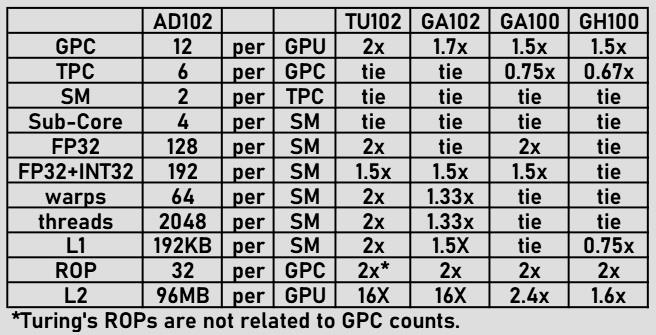Last March, we shared an important round of information about the GeForce RTX 40, which generally provided us with almost all the keys to this new generation of graphics cards that NVIDIA could launch in the second half of this year. Now, thanks to a new round of leaks, we have new details Dive deeper into the AD102 kernel configurationtop GPU that NVIDIA will use in Ada Lovelace.
In the attached picture we can see that theoretically the GPU AD102 comes with a configuration 12 GPC (Graphics Processing Clusters), 6 TPC (Texture Processing Clusters) on GPC, two SM (Streaming Multiprocessors) units on TPC, 128 shaders or FP32 units on SM, 192 FP32 + INT32 units on SM and 64 warps per SM unit. You should have a total of 2,048 threads per SM drive, 192 KB of L1 cache per SM, 32 ROP for each active GPC and 96 MB of L2 cache.
From all this data, we can clarify very important things if the information is confirmed. The top model of the GeForce RTX 40 series would count if it used a full-fledged AD102 GPU, p 70% more GPC units than the GA102 chip, the top of the line Ampere for general consumption, which was recently used in the GeForce RTX 3090 Ti. It would also have a different configuration in the FP32 and INT32 units, which would be differentiated and adds 128 and 64 cores, resp. This means a 50% increase over the GA102 core.
Other important changes compared to the GA102 core would be a 33% increase in warps, a 33% increase in threads, a 50% increase in L1 cache, a 160% increase in L2 cache and a 100% increase in ROP (rasterization units). The latter is very interesting, because if confirmed, it would mean that the GeForce RTX 4090 could have a huge 384 ROP. Just to give you an idea, the RTX 3090 Ti has 112 ROPs.


GeForce RTX 40 vs. GeForce RTX 30: Concise and clear summary
From all the information we have seen so far, we can prepare a complete and straightforward list that includes all changes and improvements, that GeForce RTX 40 will bring compared to GeForce RTX 30. Keep in mind that we based this list on rumors and leaks, which means that some of the data we’ll see below may not be true.
- Huge increase in the number of active shaders (up to 18,432 in the AD102 core).
- GPC rasterization units are doubled, which should represent a significant improvement in rasterization performance. These units take care of “composing” all the work of the rest of the GPUs to create an image that will go into the frame buffer and which we will see on the monitor.
- Increased L1 and L2 cache.
- 4th generation Tensor cores and 3rd generation RT cores, which should improve performance in AI and DLSS and with ray tracing.
- Switch to an improved 5nm node (N4), which could theoretically help improve efficiency and operating frequencies.
Given all this, it is quite clear to me The generation leap we will see with the GeForce RTX 40 will be huge, both in rasterization and ray tracing, although something tells me that with this latest technology it will be especially great. In terms of consumption, there has also been a significant increase, especially for the most powerful models in the GeForce RTX 40 series, but I think we should take them with a grain of salt, because some ridiculously high numbers were considered.